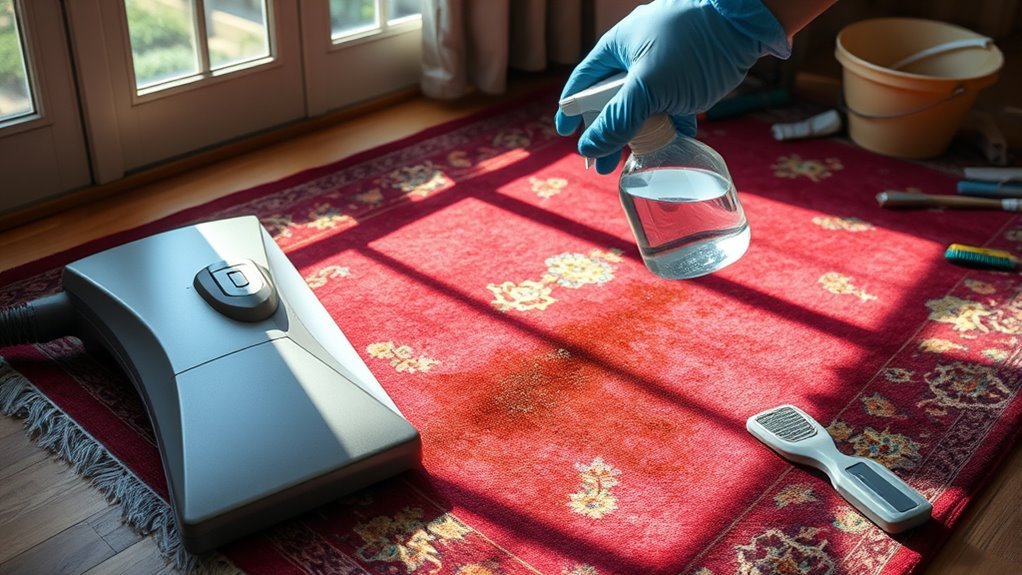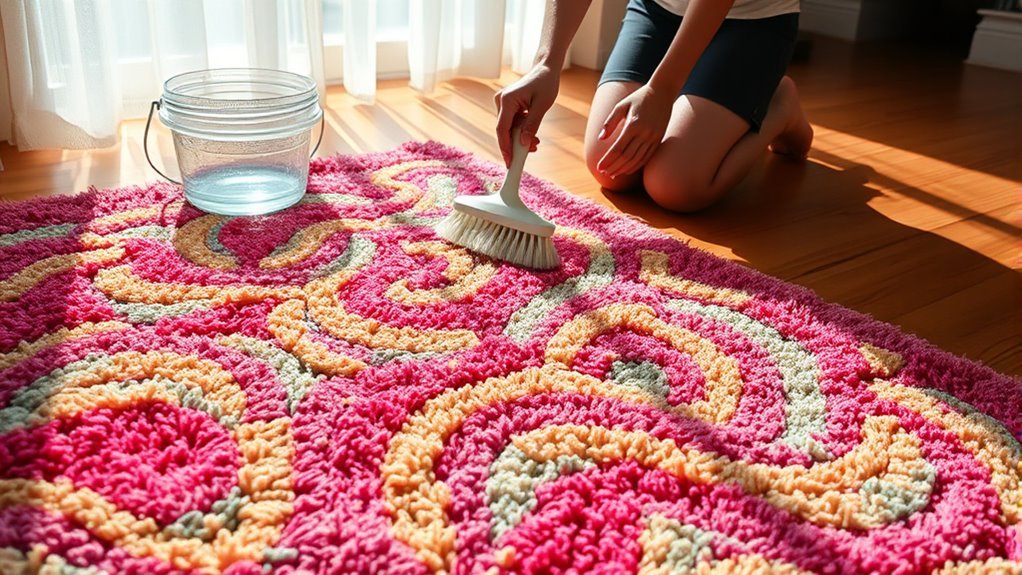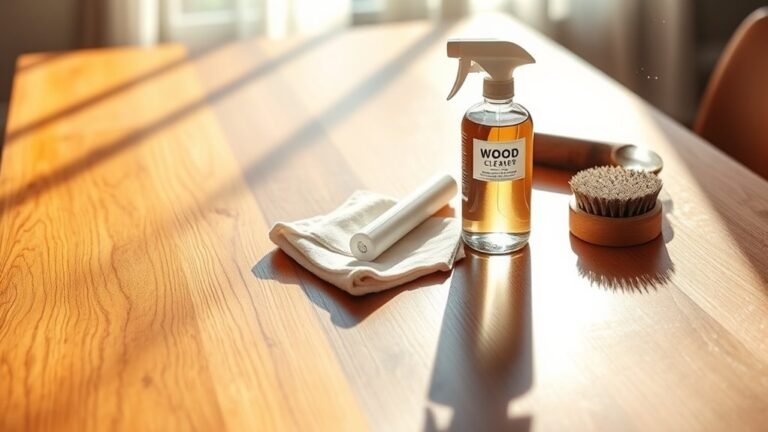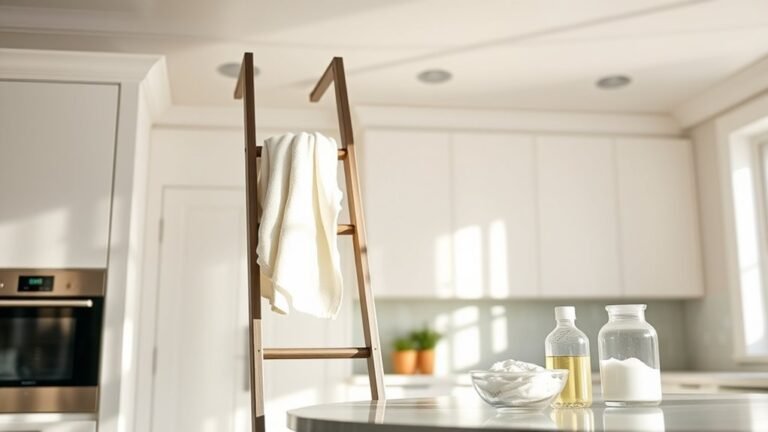Cleaning With Rug: What Works and What Doesn’T
When cleaning your rug, use tools like a soft-bristle brush and a vacuum with adjustable settings to protect fibers. Always blot spills gently with a microfiber cloth—never scrub, or you risk pushing stains deeper. Avoid harsh chemicals and over-wetting, which can cause damage or mold. Different materials need tailored care—wool and oriental rugs require extra gentleness, while synthetics handle more robust cleaning. Keep these basics in mind, and you’ll soon find ways to preserve your rug’s look and feel longer.
Understanding Different Types of Rugs

Before you immerse yourself in cleaning, it’s important to understand the different types of rugs you’ll be working with. Wool rugs and Persian rugs, often made from natural fibers, require gentle care to preserve their texture and color. Synthetic rugs are more durable and easier to clean, perfect for busy spaces or outdoor rugs. Oriental rugs, known for their intricate designs, need special attention to avoid damage. Shag rugs, with their long fibers, can trap dirt easily, so regular maintenance is key. Whether you’re dealing with area rugs or runner rugs, knowing their material and placement—indoor rugs versus outdoor rugs—will guide your cleaning approach. Understanding these differences frees you to maintain your rugs effectively without compromising their beauty or lifespan.
Essential Tools for Rug Cleaning
To clean your rugs effectively, you’ll need a handful of essential tools that make the job easier and protect your rug’s fibers. Start with a good-quality broom or rug beater to loosen dirt without damaging delicate threads. A gentle brush with soft bristles helps maintain your rug’s texture during spot cleaning. Microfiber cloths are perfect for blotting spills and applying cleaning solutions. A spray bottle lets you control moisture, vital for proper rug maintenance and avoiding over-wetting. Don’t forget a sturdy bucket for water and mild detergent. Keeping these tools handy supports your rug’s longevity and aligns with your preferred cleaning frequency, whether weekly or monthly. Having the right gear means you’re free to enjoy a clean, vibrant rug without hassle or damage.
Effective Vacuuming Techniques

Once you have the right tools ready, vacuuming becomes one of the most effective ways to keep your rugs clean. To truly free your space from dirt, you need to adjust your vacuum settings based on your rug types. Here’s how you can maximize your vacuuming efficiency:
- Choose the correct vacuum setting for delicate or high-pile rugs to avoid damage.
- Vacuum in multiple directions to lift dirt trapped in fibers.
- Use a vacuum with strong suction but gentle brushes to protect the rug.
- Don’t rush; slow, deliberate passes pick up more debris.
- Regularly empty the vacuum bag or canister to maintain suction power.
Spot Cleaning: What Works Best
When a spill happens, you’ll want to act fast with the right stain removal methods to protect your rug. Choosing safe cleaning solutions is key to avoiding damage while effectively lifting spots. Plus, quick drying helps prevent mold and keeps your rug looking fresh.
Effective Stain Removal
Although stains on rugs can feel overwhelming, acting quickly with the right techniques can save your carpet from permanent damage. Understanding stain types and adjusting cleaning frequency based on use is key to maintaining your rug’s freedom from stubborn marks. Here’s how you can tackle stains effectively:
- Blot spills immediately to prevent spreading.
- Use cold water for protein-based stains like blood or sweat.
- Apply gentle pressure; avoid scrubbing to protect fibers.
- Repeat cleaning only as needed—overdoing it can damage your rug.
- Test any cleaning method on a small, hidden area first.
Safe Cleaning Solutions
Because rugs come in various materials and we all want to protect their look and feel, choosing the right cleaning solution is crucial. When spot cleaning, you’ll want to reach for eco friendly cleaners or natural solutions that won’t harm fibers or colors. Simple ingredients like white vinegar, baking soda, and mild liquid soap often do the trick without harsh chemicals. Avoid bleach or anything abrasive, as that can ruin your rug and limit your freedom to enjoy it. Test any cleaner on a hidden area first to verify it won’t cause damage. By using gentle, natural options, you keep your rug vibrant and your space safe—letting you clean confidently without worrying about unwanted side effects.
Quick Drying Techniques
Choosing the right cleaning solution is only part of keeping your rug looking its best; knowing how to dry it quickly after spot cleaning makes a big difference too. Quick drying methods not only prevent mildew but also get your rug back in action faster, giving you more freedom in your space. To maximize drying time reduction, try these tips:
- Blot the spot with a dry towel immediately to absorb excess moisture.
- Use a fan or open windows to boost air circulation around the rug.
- Avoid direct heat, which can damage fibers; opt for gentle warmth.
- Elevate the rug slightly to allow air to flow underneath.
- Apply a small amount of rubbing alcohol to speed evaporation without harming the fabric.
These quick drying techniques help your rug stay fresh and ready for whatever comes next.
Safe Cleaning Solutions for Various Materials
When dealing with different rug materials, you’ll want to use cleaning solutions that are both effective and gentle to avoid damage. Choosing eco friendly cleaners lets you protect your rugs and the environment, giving you freedom from harsh chemicals. Wool rugs, for example, respond best to mild detergents made specifically for natural fibers, while synthetic rugs can handle stronger, yet still safe, solutions. Always opt for material specific solutions designed to maintain your rug’s texture and color. Avoid generic cleaners that might degrade delicate fibers or leave residues. By tailoring your approach, you keep your rugs looking fresh and vibrant without risking harm. This thoughtful care allows you to enjoy your space with confidence, knowing your cleaning choices support both your rug’s longevity and your values.
Common Mistakes to Avoid When Cleaning Rugs

Although cleaning rugs might seem straightforward, there are several common mistakes you’ll want to avoid to keep your rugs in great condition. Understanding these common errors helps you maintain your freedom to enjoy a fresh, beautiful space without hassle. Here are key rug cleaning mistakes to skip:
- Using harsh chemicals that damage fibers.
- Over-wetting your rug, leading to mold or shrinkage.
- Ignoring cleaning frequency—too often or too rarely harms the rug.
- Skipping regular vacuuming, which is an essential maintenance tip.
- Rubbing stains aggressively, pushing dirt deeper.
Avoiding these pitfalls guarantees your rug cleaning routine is effective and your rugs stay vibrant longer. Stick to proper maintenance tips to keep your freedom from unnecessary replacements or repairs.
Deep Cleaning Methods That Actually Help
When it comes to deep cleaning your rug, knowing how to remove stains effectively can save you a lot of trouble. You’ll also want to master proper vacuum techniques to keep dirt from settling deep into the fibers. Let’s explore methods that actually make a difference in restoring your rug’s look and feel.
Effective Stain Removal
Removing tough stains from rugs can feel overwhelming, but with the right deep cleaning methods, you can restore your rug’s appearance effectively. Understanding different stain types is key to choosing the best removal methods. Here’s what you need to know:
- Act quickly to blot spills—don’t rub, or stains set deeper.
- Use mild detergents for protein stains like blood or sweat.
- Treat oil-based stains with baking soda or cornstarch to absorb grease.
- For dye stains, try a vinegar and water solution carefully.
- Always test your cleaning solution on a small rug area first.
Proper Vacuum Techniques
Proper vacuum techniques are essential for maintaining your rug’s cleanliness and extending its lifespan. To truly free your rug from dirt and debris, pay attention to your vacuum patterns. Instead of rushing in random directions, use slow, overlapping strokes—first vertically, then horizontally. This guarantees you reach every fiber and dislodge hidden particles. Adjust your vacuum’s suction settings based on the rug’s material; delicate fibers need gentler suction, while sturdier rugs can handle stronger power. Don’t forget to clean your vacuum’s brush roll regularly to avoid redistributing dirt. By mastering these habits, you’ll keep your rug fresh without damaging it, giving you the freedom to enjoy a clean, inviting space without the hassle of frequent replacements or deep cleaning headaches.
Maintaining Your Rug’s Appearance Over Time
Although rugs can add warmth and style to any room, keeping them looking fresh requires regular care. To enjoy your rug’s beauty for years, you’ll want to embrace effective rug maintenance tips and rug protection methods. Here’s how you can maintain your rug’s appearance over time:
Rugs bring warmth and style but need regular care to stay fresh and beautiful over time.
- Rotate your rug every few months to guarantee even wear.
- Use rug pads underneath to prevent slipping and protect the fibers.
- Avoid direct sunlight to reduce fading and discoloration.
- Clean spills immediately to prevent stains from setting in.
- Schedule professional cleanings annually for deep refreshment.
Frequently Asked Questions
Can Rug Cleaning Improve Indoor Air Quality?
Yes, rug cleaning can improve indoor air quality by reducing airborne allergens and dust mites trapped in fibers. When you clean your rug regularly, you’re freeing your space from these irritants that often cause sneezing or breathing issues. It’s a simple way to reclaim your freedom to breathe easy at home. Just make sure to use the right cleaning methods to avoid damaging your rug while keeping the air fresh and healthy.
How Often Should Professional Rug Cleaning Be Scheduled?
You don’t want your rug to endure a century of dirt buildup, right? Frequency recommendations usually suggest getting a professional cleaning every 12 to 18 months, but it depends on your lifestyle and space. If you’ve got pets or heavy foot traffic, you might need more frequent cleaning schedules. Trust your freedom to choose what feels right—just don’t wait so long that your rug starts telling tales of neglect!
Are There Eco-Friendly Rug Cleaning Alternatives?
You’re in luck if you want eco-friendly rug cleaning alternatives! You can try natural cleaners like vinegar and baking soda, which work great for removing odors and stains without harsh chemicals. DIY solutions also give you freedom to customize your cleaning mix using essential oils or lemon juice. These options are not only gentle on your rug but also better for the environment, so you can keep your space fresh and green effortlessly.
What Is the Best Way to Dry a Wet Rug?
Drying a wet rug is like letting the morning sun chase away the night’s dampness. You’ll want to use rug drying techniques that prioritize effective ventilation—open windows, turn on fans, or use a dehumidifier to speed things up. Hang your rug over a sturdy line or railing, letting air flow freely through it. Avoid direct sunlight too long to preserve colors. This way, your rug dries quickly and stays fresh, freeing you from worry.
Can Rugs Attract Pests, and How to Prevent This?
Yes, rugs can attract pests like dust mites and carpet beetles. To keep your space free and easy, focus on regular rug maintenance—vacuum often and clean spills immediately. Pest prevention also means airing out rugs to avoid moisture buildup, which pests love. Using natural repellents or essential oils can help, too. By staying proactive, you’ll enjoy a pest-free, comfortable environment without feeling trapped by endless cleaning chores.






